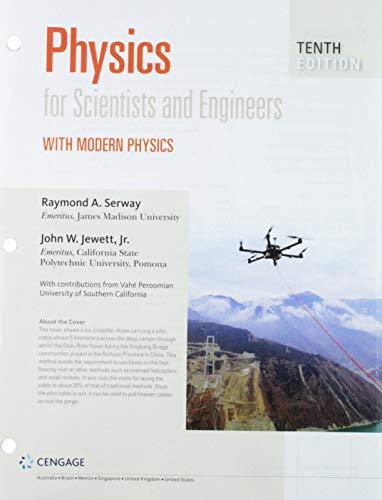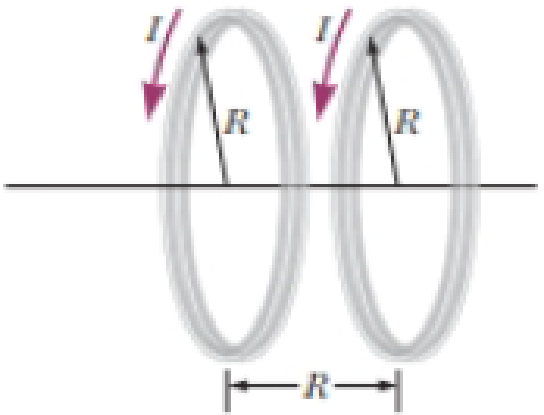
Two circular coils of radius R, each with N turns, are perpendicular to a common axis. The coil centers are a distance R apart. Each coil carries a steady current I in the same direction as shown in Figure P29.38. (a) Show that the magnetic field on the axis at a distance x from the center of one coil is

(a)
To show: The magnetic field on the axis at a distance
Answer to Problem 38AP
Hence, the magnetic field on the axis at a distance
Explanation of Solution
Given information: The radius of each coil is
Let consider a point at
Formula to calculate the magnetic field at a point due to first circular coil is,
Here,
Formula to calculate the magnetic field to the same point due to second circular coil is,
Here,
Write the expression for the net field at the given point.
Substitute
Simplify the above equation for
Conclusion:
Therefore, the magnetic field on the axis at a distance
(b)
To show: The value of
Answer to Problem 38AP
Hence, the value of
Explanation of Solution
Given information: The radius of each coil is
From equation (3), the expression for the net magnetic field is given by,
Differentiate the above equation with respect to
Substitute
Thus, the value of value of
Differentiate the equation (4) with respect to
Substitute
Thus, the value of value of
Conclusion:
Therefore, the value of
Want to see more full solutions like this?
Chapter 29 Solutions
Bundle: Physics For Scientists And Engineers With Modern Physics, Loose-leaf Version, 10th + Webassign Printed Access Card For Serway/jewett's Physics For Scientists And Engineers, 10th, Single-term
Additional Science Textbook Solutions
SEELEY'S ANATOMY+PHYSIOLOGY
Fundamentals of Physics Extended
Chemistry: Atoms First
Brock Biology of Microorganisms (15th Edition)
Human Biology: Concepts and Current Issues (8th Edition)
Human Physiology: An Integrated Approach (8th Edition)
- A 23.0-mw (mill:-Watts) laser puts out a narrow cyclindrical beam 50 mm in diameter. What is the average N/C. rms E-field?arrow_forwardThe average intensity of light emerging from a polarizing sheet is. 0.550 W/m², and the average intensity of the horizontally polarized light incident on the sheet is 0.940 W/m². Determine the angle that the transmission axis of the polarizing sheet makes with the horizontalarrow_forwardwe measure an At a particular moment in time and space, electromagnetic wave's electric and magnetic fields. We find the electric field & pointing North and the magnetic field B pointing Down. What is the direction of wave propagation? a. South b. West C. c. Up d. Down e. East f. North.arrow_forward
- Hello, please help with how to calculate impact velocity and rebound velocity. Thanks!arrow_forwardA object of mass 3.00 kg is subject to a force FX that varies with position as in the figure below. Fx (N) 4 3 2 1 x(m) 2 4 6 8 10 12 14 16 18 20 i (a) Find the work done by the force on the object as it moves from x = 0 to x = 5.00 m. J (b) Find the work done by the force on the object as it moves from x = 5.00 m to x = 11.0 m. ] (c) Find the work done by the force on the object as it moves from x = 11.0 m to x = 18.0 m. J (d) If the object has a speed of 0.400 m/s at x = 0, find its speed at x = 5.00 m and its speed at x speed at x = 5.00 m speed at x = 18.0 m m/s m/s = 18.0 m.arrow_forwardAn EL NIÑO usually results in Question 8Select one: a. less rainfall for Australia. b. warmer water in the western Pacific. c. all of the above. d. none of the above. e. more rainfall for South America.arrow_forward
- A child's pogo stick (figure below) stores energy in a spring (k = 2.05 × 104 N/m). At position (✗₁ = -0.100 m), the spring compression is a maximum and the child is momentarily at rest. At position ® (x = 0), the spring is relaxed and the child is moving upward. At position child is again momentarily at rest at the top of the jump. Assume that the combined mass of child and pogo stick is 20.0 kg. B A (a) Calculate the total energy of the system if both potential energies are zero at x = 0. (b) Determine X2- m (c) Calculate the speed of the child at x = 0. m/s (d) Determine the value of x for which the kinetic energy of the system is a maximum. mm (e) Obtain the child's maximum upward speed. m/s thearrow_forwardAn EL NIÑO usually results in Question 8Select one: a. less rainfall for Australia. b. warmer water in the western Pacific. c. all of the above. d. none of the above. e. more rainfall for South America.arrow_forwardEarth’s mantle is Question 12Select one: a. Solid b. Liquid c. Metallic d. very dense gasarrow_forward
- Silicates Question 18Select one: a. All of these b. Are minerals c. Consist of tetrahedra d. Contain silicon and oxygenarrow_forwardWhich of the following is not one of the major types of metamorphism? Question 20Select one: a. Fold b. Contact c. Regional d. Sheararrow_forwardA bungee jumper plans to bungee jump from a bridge 64.0 m above the ground. He plans to use a uniform elastic cord, tied to a harness around his body, to stop his fall at a point 6.00 m above the water. Model his body as a particle and the cord as having negligible mass and obeying Hooke's law. In a preliminary test he finds that when hanging at rest from a 5.00 m length of the cord, his body weight stretches it by 1.55 m. He will drop from rest at the point where the top end of a longer section of the cord is attached to the bridge. (a) What length of cord should he use? m (b) What maximum acceleration will he experience? m/s²arrow_forward
 Physics for Scientists and Engineers: Foundations...PhysicsISBN:9781133939146Author:Katz, Debora M.Publisher:Cengage Learning
Physics for Scientists and Engineers: Foundations...PhysicsISBN:9781133939146Author:Katz, Debora M.Publisher:Cengage Learning Principles of Physics: A Calculus-Based TextPhysicsISBN:9781133104261Author:Raymond A. Serway, John W. JewettPublisher:Cengage Learning
Principles of Physics: A Calculus-Based TextPhysicsISBN:9781133104261Author:Raymond A. Serway, John W. JewettPublisher:Cengage Learning Physics for Scientists and Engineers, Technology ...PhysicsISBN:9781305116399Author:Raymond A. Serway, John W. JewettPublisher:Cengage Learning
Physics for Scientists and Engineers, Technology ...PhysicsISBN:9781305116399Author:Raymond A. Serway, John W. JewettPublisher:Cengage Learning Physics for Scientists and Engineers with Modern ...PhysicsISBN:9781337553292Author:Raymond A. Serway, John W. JewettPublisher:Cengage Learning
Physics for Scientists and Engineers with Modern ...PhysicsISBN:9781337553292Author:Raymond A. Serway, John W. JewettPublisher:Cengage Learning Physics for Scientists and EngineersPhysicsISBN:9781337553278Author:Raymond A. Serway, John W. JewettPublisher:Cengage Learning
Physics for Scientists and EngineersPhysicsISBN:9781337553278Author:Raymond A. Serway, John W. JewettPublisher:Cengage Learning





